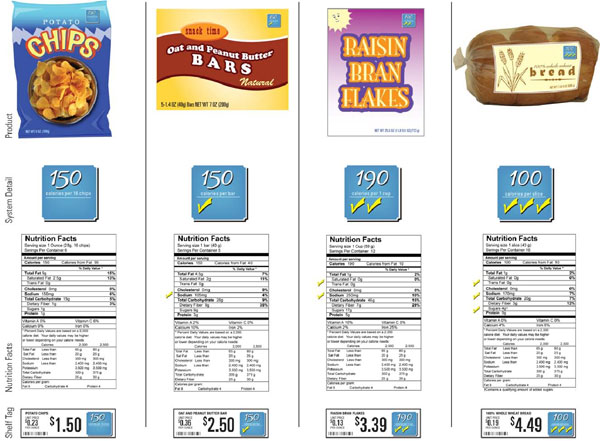New Nutrition Symbols Would Help Shoppers Be Healthier

The barrage of symbols and health claims on food these days may leave consumers confused about which products are truly good for them. To help clear this confusion, federal agencies should develop a new nutritional rating system that will standardize the symbols on the front of food packages and make it easy for people to discern how healthy a product is, a new government report says.
The report, issued by the Institute of Medicine, recommended that a single symbol be displayed on the front of packages. The symbol contains two pieces of information: the number of calories per serving, and a score that rates products based on their nutritional content. Foods with high amounts of unhealthy nutrients, such as added sugar and sodium, would earn fewer points.
This new system should apply to all foods and beverages and replace any other symbols currently being used on the front of packaging, the report said.
"A successful front-of-package nutrition rating system would enable shoppers to instantly recognize healthier products by their number of points and calorie information," said Ellen Wartella, a professor of psychology and communication at Northwestern University in Evanston, Ill., and chair of the committee that wrote the report.
"It would encourage food and beverage producers to develop healthier fare, and consumers to purchase products that are lower in calories and food components that contribute to chronic disease," Wartella said.
New symbols
The report outlines a rating system in which foods and beverages earn points if their amounts of "nutrients of concern" are at or below certain levels.
Sign up for the Live Science daily newsletter now
Get the world’s most fascinating discoveries delivered straight to your inbox.
Products could earn up to three points, one each for having low-enough amounts of sodium, added sugars and saturated and trans fats. The more points a food or beverage has, the healthier it is.
For example, 100 percent whole-wheat bread could qualify for all three points, while graham crackers (which have added sugar) could earn two points for having low levels of sodium and saturated and trans fats. The points would be graphically displayed on packaging as check marks, stars, or some other icon. [See images of the proposed symbols]
But foods and beverages should also have to meet a separate set of criteria to be eligible to earn points at all, the report said. If a product greatly exceeds the eligibility criteria for any one of the nutrients of concern, it would not earn any points. For example, a sugar-sweetened soda could not earn points for having low sodium and no saturated or trans fats if its added sugar content was too high.
Whether a food or beverage qualifies for points or not, it should prominently display the amount of calories per serving, and servings should be described in familiar measurements, such as per slice or per cup. The front-of-package icons should also direct shoppers to the Nutrition Facts Panel on the reverse, to get additional information.
Developing a system
The new symbols should appear on all grocery products so that shoppers can readily compare food choices within categories, such as breakfast cereals, as well as across categories, such as fresh produce, frozen vegetables and canned soups, the committee said. Food manufacturers and retail outlets should display the symbols in consistent locations.
The report offers examples of what representative symbols and displays could look like purely for illustrative purposes; the committee does not endorse any particular graphic. The FDA will need to develop and test potential icons and displays.
The FDA should also launch an educational campaign to promote the rating system and its symbols when they are finalized, the report said. Promotion, along with universal display on all products, is key to helping shoppers understand and take advantage of the new rating system, the committee said.
The study was sponsored by the Centers for Disease Control and Prevention, the Food and Drug Administration and the U.S. Department of Agriculture Center for Nutrition Policy and Promotion.
Pass it on: Federal agencies should standardize the symbols displayed on the front of food packages so that they are able to simply convey how healthy a particular food item is, the Institute of Medicine says.
This story was provided by MyHealthNewsDaily, a sister site to LiveScience. Follow MyHealthNewsDaily on Twitter @MyHealthNewsDaily. Find us on Facebook.










